The old Jewish cemetery
This remarkable feature of Ipswich history, is in 2014 (and for
many years) hidden away. It has featured on the website only as
embodying two St Clement Parish boundary
markers. The gate is locked apart from occasional grass-strimming
and tidying up; we assume that the beating of the bounds of the parish
(as featured in Victorian photographs) which used to include the
interior of this tiny Jewish cemetery is not practised in the
twenty-first century. It is known that there was a
synagogue in Rope Walk; it was demolished in 1877.
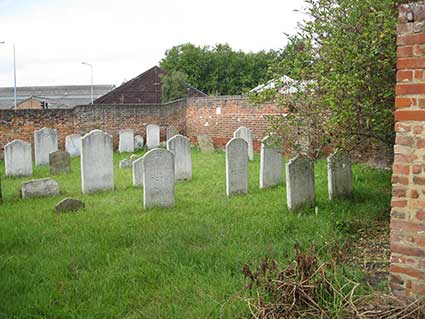 2014
images
2014
images  Bird's
eye view
Bird's
eye view
"The Society was pleased to hear from Ipswich Borough Council that the
Department of Culture, Media and Sport has Listed (Grade II) the
boundary walls of this little known but historically important site.
The walls enclosing the burial ground on four sides were built c1764
and survive essentially intact. Other reasons given by the DCMS for
Listing are that this is 'an important reminder of the existence of a
Jewish community' and 'there is a special historic interest in the
continuous settlement in England of this oldest non-Christian minority
group and the tolerance afforded to it by the local population.'
The DCMS schedule outlines the history of Jews in Ipswich. There was a
community in the Middle Ages but Edward I [1239-1307] expelled the Jews
from
England in 1290. At Cromwell's invitation Jews returned in 1656 and
settled in London. By 1750 Ipswich had an established Jewish
population, worshipping in a rented room. They built a synagogue in
Rope Lane (now Rope Walk) and acquired the land, already enclosed by
these walls, in 1796. But the population declined in the 19th century,
the burial ground was closed in 1855 and the disused synagogue pulled
down in 1877. The Jewish Board of Deputies took over responsibility for
the site and, after World War II, BOCM Pauls maintained the site for
the Board of Deputies, although no maintenance has been carried out
recently.
The burial ground contains 36 tombstones arranged in seven rows largely
chronologically. They have inscriptions in Hebrew or some in Hebrew and
English. The earliest dated tombstone is 1797/8 (Jewish year 5558).
Some inscriptions are no longer legible because of weathering.
... Mr Leonard Woolf ... has contributed more information. There are 14
such burial grounds of the period outside London, mostly and
significantly in coastal and port towns. Similar Listing of the
enclosing walls has been done at Kings Lynn and Exeter."
Excepts from The Ipswich
Society Newsletter, October 2008, January 2009
From the gate one can make out a couple of tombstones with
recognisable Hebrew characters carved into them. Others have eroded
over the centuries.
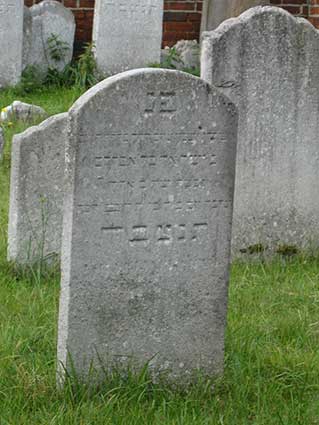

For once, the English Heritage Listing (British Listed Buildings, see Links) text for the walls surrounding this
burial ground is extensive and informative. We include a précis of the
text here because it is fascinating.
'Red brick boundary walls to Jewish
cemetery, c1764 with later repairs. In use as a Jewish burial ground
1796-1855. Listed Grade II.
The walls enclose the burial ground on four sides. Access is via an
iron gate on the east side. There are two boundary marker stones set
into the walls, said to date from the reign of George II. The marker on
the exterior right side of the entrance gate is for St Clements Parish
and the one in the internal left corner of the north wall is for St
Mary Key [our St Clement boundary
marker photographs seem to contradict this]. There is a buttress on
the inner side of the north wall.
The burial ground contains 36 tombstones of limestone, marble and
Yorkstone, including three smaller footstones. The stones are all
upright and arranged in seven rows in largely chronological order, and
have inscriptions in Hebrew or Hebrew and English. Two or three stones
have broken at the top, and the inscriptions on a number of the stones
are no longer legible due to weathering. The earliest dated tombstone
is 1797/8 (Jewish year 5558), and the latest is 1850. The stones are
dedicated to members of the Ipswich Jewish community and other Jews
from Harwich (2), Bury St Edmunds, Colchester (3) and one from London.
At least three of the stones are dedicated to children.
There was a Jewish community in Ipswich in the Middle Ages, but it
dispersed when Edward I expelled the Jews from England in 1290. At
Cromwell's invitation Jews returned to England in 1656 and settled in
London. During the Jacobite Rebellions some Jews left London to
establish trade in the port towns, Ipswich being one of these. By 1750
Ipswich had an established Jewish population, and they worshipped in a
rented room. By 1792 the congregation numbered at least thirty families
from Ipswich and the area and they were able to start building a
synagogue on a site in Rope Lane (now Rope Walk, erected through the
generosity of two benefactors, Simon Hyam and Lazarus Levi. Many
members of the Ipswich congregation were shopkeepers and tradesmen,
involved in the traditional occupations of garment-selling and
watch-making.
Having built a synagogue, the community set about acquiring a cemetery.
On 6 May 1796 they purchased a 999-year lease on an enclosed plot of
land in the Parish of St Clement from a bricklayer named Benjamin
Blasby, for £28 and a peppercorn rent. The walls of the enclosure had
been put up in at least 1764 and it was known as Rogers' Court after
the then owner. Eight trustees were appointed for the cemetery, headed
by Simon Hyam and Lazarus Levi, and including two Colchester residents.
It is unknown how many burials took place in the cemetery, as there
were evidently more graves than the number of tombstones. One of the
burials was Sarah Lyon or Lyons, who died in 1808 at the age of 105.
She was famous for her ripe old age and John Constable painted her
portrait in 1804 when she was 101 years old. She was said to be the
earliest Jewish settler in Ipswich in modern times.
By 1830 there were no more than fifty Jewish people in Ipswich and the
synagogue was in poor repair. By 1867 it had fallen into disuse, and in
1877 it was pulled down. When Hermann Gollancz visited Ipswich in 1895,
there were only three Jewish people still resident in the town. Twenty
years later the Ipswich Jewish community was nothing but a memory. The
burial ground was closed on 1 July 1855 under the Burial Act, and a
Jewish plot was acquired in the municipal cemetery for future burials.
After the closure the burial ground fell into disrepair, and by 1879 it
was in a deplorable state, having been converted into a poultry yard
and later a refuse dump. In 1893 the London Committee (now Board) of
Deputies of British Jews took over responsibility for maintenance of
the site. The Ohel (prayer hall) once attached to the burial ground had
fallen into such a state of neglect that it had been claimed by a
neighbour as his own property.
The Board of Deputies undertook a number of repairs to the brick walls
in the late 19th century and 20th century,
including rebuilding the top of the north wall after a severe gale in
1895, and rebuildings of the west wall in 1912 and 1918. By 1912, the
firm of R & W Pauls (later BOCM Pauls) owned all the land and
buildings surrounding the burial ground. After WWII the adjoining
tenements were demolished but the burial ground was preserved and
maintained by BOCM Pauls for the Board of Deputies.
Four separate surveys have been made of the burial ground, recording
the inscriptions on the tombstones and their locations: in 1875-1900 by
Rev. Francis Haslewood, Anglican Rector of St Matthew; in 1895 by Rev.
Hermann Gollancz, a Jewish minister; in 1980 by Dr Nicholas de Lange
and Sarah Montagu of University of Cambridge; and in 2001 by Alan
Coleman of Suffolk College. None of the tombstones have been removed
since the late 19th century surveys.
The burial ground serves as an important reminder of the existence of a
Jewish community in Ipswich, which had been extinguished by the end of
the 19th century. There is special
historic interest in the continuous settlement in England of this
oldest non-Christian minority group and the tolerance afforded it by
the local population.'
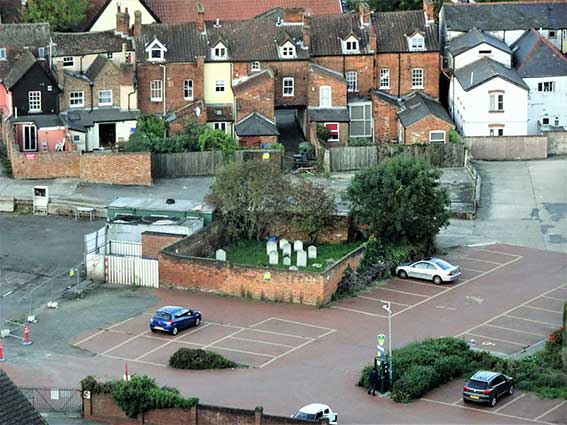 2018,
courtesy Tim Leggett
2018,
courtesy Tim Leggett
Above: the cemetery seen from the top of the Winerack, photographed by
Tim Leggett. The rear of the house with the 'Cor Visser' blue plaque is at upper left.
[UPDATE 21.9.2018: ‘I
was fascinated to read your piece on the Jewish cemetery. I knew of its
existence, and also of the synagogue. It's also very timely at this
present time of the rise of anti-semitism. We should remember that the
Jewish community have brought a lot to this country whilst also
accepting our laws and integrating so well. Glynis Baker.’]
Beating the Bounds in the cemetery
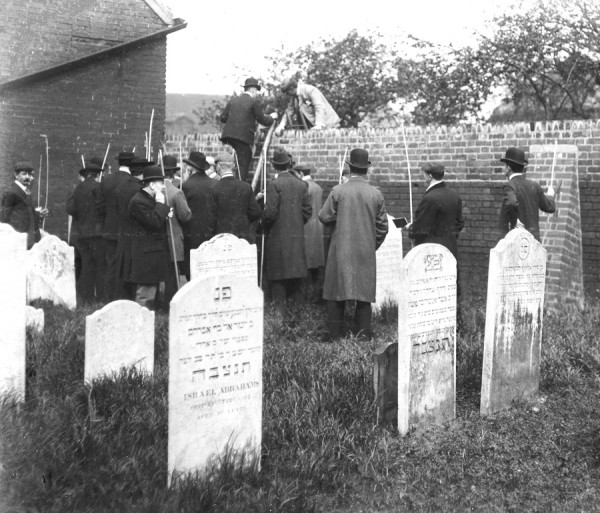 image
courtesy Ipswich Historic Churches Trust
image
courtesy Ipswich Historic Churches Trust
The remarkable photograph, above, shows the ritual of Beating the
Bounds of St Clement Parish (probably in
the Edwardian era?) in the cemetery, complete with ladders to scale the
walls and canes to tap the boundary markers; image found on both
sources quoted below.
Two sources for 'Beating the Bounds' of St Clement Parish:
The Ipswich Society's Newsletter (October 2016, Issue
206) carries a
reprint of an article about this ritual in 1895.
To accompany this, see the set
of photographs of Beating the Bounds on the Ipswich Historic
Churches Trust website.
See Links for both organisations.
Alderman
Abraham Raphael Jr
[UPDATE 6.6.2020: 'My
name is Nicholas Raphael, and in the course of researching my family
history I came across the pages on your website concerning Christ's
Hospital, Union Workhouse, Board of Guardians and the historic Jewish
Cemetery.
The reason I am contacting you is that my third great uncle – Alderman
Abraham Raphael Jr – attended the Christ's Hospital School some time
during the 1860s, before serving on the Board of Guardians (1879-1890),
as longstanding secretary of the local Conservative Club (1888-1893),
and briefly as Alderman on the County Borough of Ipswich between May
and November 1891. His father, Abraham Raphael Sr, had arrived in
Ipswich in dubious circumstances sometime in the 1830s, and operated a
hat store located on Fore Street depicted in a painting Angel Corner by
Thomas Smythe in c.1860
(https://www.ipswichstar.co.uk/news/ipswich-paintings-could-fetch-thousands-1-167320).
As a third-generation British Jew and second-generation Ipswich
resident, Abraham Jr. became the last caretaker of the historic first
Jewish cemetery in Ipswich, and introduced the noted Jewish Rabbi and
scholar Sir Hermann Gollancz* to the site in 1894.
I noticed his name inscribed on the Union Workhouse plaque displayed on
http://www.ipswich-lettering.co.uk/workhouse.html, and thought I'd pass
this in in case it was of interest. Out of interest, who is in
possession of the plaque today?
Many thanks, Nic Raphael (Sydney, Australia).' Many thanks to Nic for letting us know
about his ancestor's relationship to the Old Jewish Cemetery, Christ's
Hospital School and the Union Workhouse.]
– *Sir Hermann Gollancz (1852-1930) was a British rabbi and Hebrew
scholar. He was the first Jew to earn a Doctor of Literature degree
from London University and the first holder of the degree to be
ordained as a rabbi. He was the first British rabbi to be granted a
knighthood, when he was knighted in 1923. He was the uncle of the
famous publishe Victor Gollancz. –
In fact Thomas Smythe (1825-1907) painted the Angel Corner scene a
number of times
and one particular work (c. 1850) was somehow familiar. It shows
Abraham Raphael
Senior's shop in the left foreground (with, presumably, Salthouse Lane
in
front); to the right in the background is The Lion & Lamb public
house, then Angel Lane is defined by the nearby Angel public house,
then St Clements Church Lane. The main thoroughfare running from lower
right towards mid-left is Fore Street. Fore
Street Baths now stand at the right of this view. This painting was
used on cover
of the late Frank Grace's book Rags
and bones (see Reading list), as shown
on our Courts and yards page.
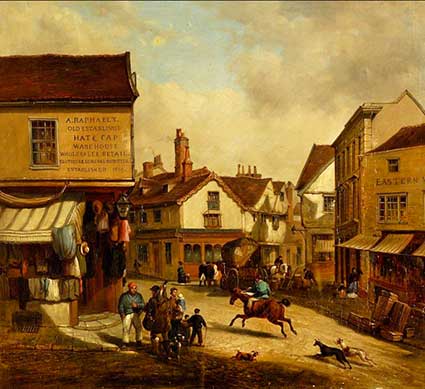

The above painting is in the
collection of Ipswich Borough Council.
Of the three versions of the scene by Smythe we've seen, the hat shop
lettering on
the plasterwork is fullest and clearest here:
'A.RAPHAEL'S
OLD ESTABLISHED
HAT & CAP
WAREHOUSE
WHOLESALE & RETAIL.
CLOTHIER & GENERAL OUTFITTER
ESTABLISHED 1839.'
Home
Please email any comments
and contributions by clicking here.
Search Ipswich
Historic Lettering
©2004 Copyright
throughout the Ipswich
Historic Lettering site: Borin Van Loon
No reproduction of text or images without express
written permission
 2014
images
2014
images  Bird's
eye view
Bird's
eye view

 2018,
courtesy Tim Leggett
2018,
courtesy Tim Leggett image
courtesy Ipswich Historic Churches Trust
image
courtesy Ipswich Historic Churches Trust
